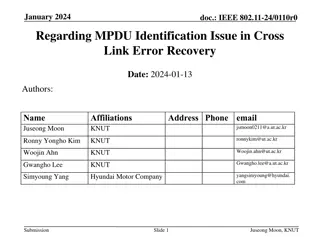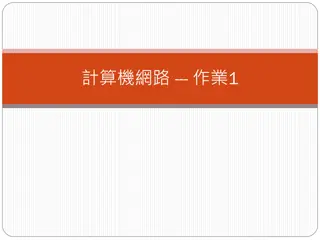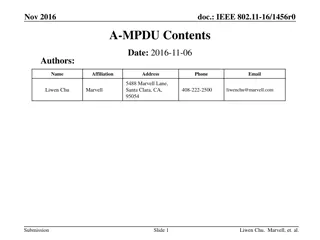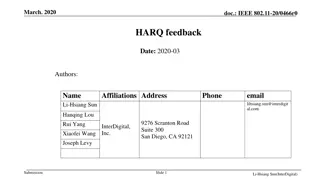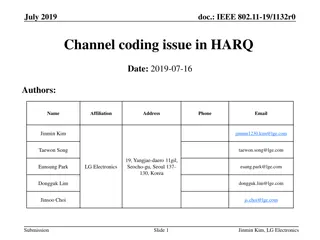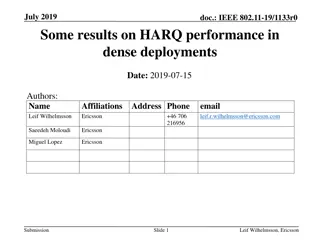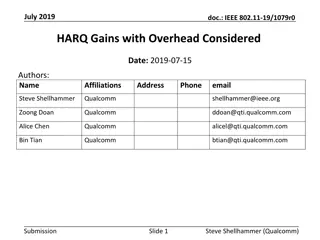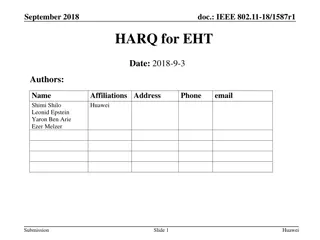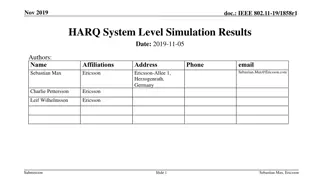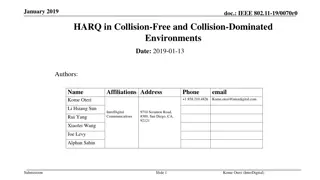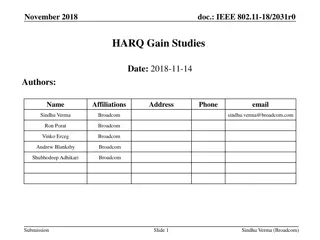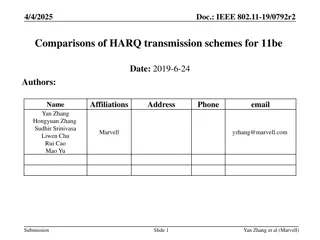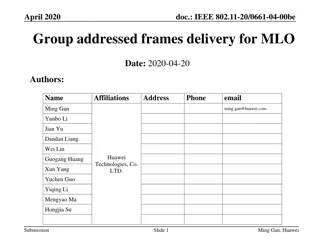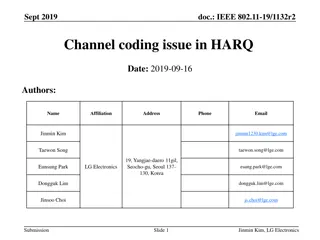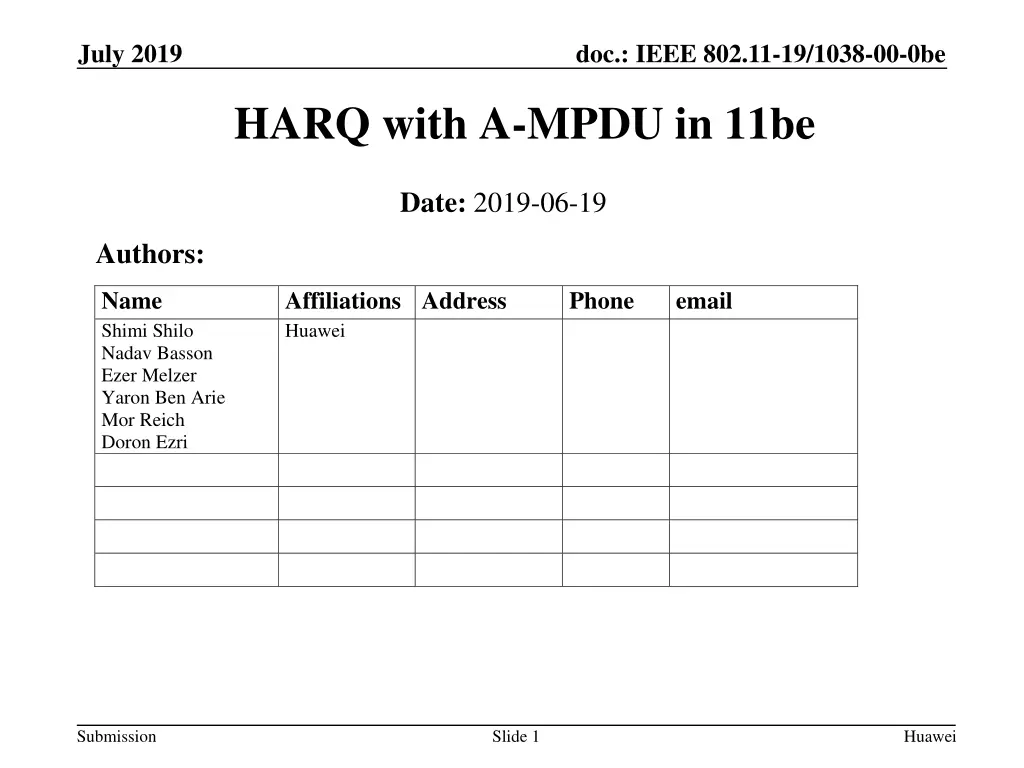
IEEE 802.11-19/1038-00-0be: Hybrid Automatic Repeat Request
Discussion on supporting HARQ in IEEE 802.11, addressing misalignment issues between A-MPDU and LDPC codewords with potential solutions. Details on existing procedures and challenges in retransmitting failed MPDUs in A-MPDU communications.
Download Presentation

Please find below an Image/Link to download the presentation.
The content on the website is provided AS IS for your information and personal use only. It may not be sold, licensed, or shared on other websites without obtaining consent from the author. If you encounter any issues during the download, it is possible that the publisher has removed the file from their server.
You are allowed to download the files provided on this website for personal or commercial use, subject to the condition that they are used lawfully. All files are the property of their respective owners.
The content on the website is provided AS IS for your information and personal use only. It may not be sold, licensed, or shared on other websites without obtaining consent from the author.
E N D
Presentation Transcript
July 2019 doc.: IEEE 802.11-19/1038-00-0be HARQ with A-MPDU in 11be Date: 2019-06-19 Authors: Name Shimi Shilo Nadav Basson Ezer Melzer Yaron Ben Arie Mor Reich Doron Ezri Affiliations Address Huawei Phone email Submission Slide 1 Huawei
July 2019 doc.: IEEE 802.11-19/1038-00-0be Background Various contributions on Hybrid Automatic Repeat Request (HARQ) have been presented in previous meetings [1-7] In this contribution, we want to discuss some issues related to supporting HARQ in 802.11, in particular to the misalignment that can occur between an A-MPDU and the LDPC codewords We then present some potential solutions for this misalignment issue, and discuss their pros and cons Submission Slide 2 Huawei
July 2019 doc.: IEEE 802.11-19/1038-00-0be Existing Procedure The 802.11 specs (and hence respective implementations) assume the following: The PHY receives a PSDU from the MAC layer and is not aware of the MPDU boundaries, their length, delimiters, etc. The FEC (LDPC) operates on blocks of information bits, regardless of MPDU boundaries A Block ACK (BA) indicates which MPDUs (within the A-MPDU) were decoded correctly, so retransmission occurs only for incorrectly decoded MPDUs Submission Slide 3 Huawei
July 2019 doc.: IEEE 802.11-19/1038-00-0be A-MPDU and LDPC: Retransmissions Assuming an A-MPDU was transmitted and some of the MPDUs were incorrectly decoded, the transmitter will have to retransmit only those MPDUs that failed failed failed For example, in the figure, an A-MPDU containing 5 MPDUs (2000 bits each) is transmitted using coding rate 1/2, where the 2nd and 3rd MPDUs failed and need to be retransmitted MPDU #1 Bits 0-1999 MPDU #2 Bits 2000-3999 MPDU #3 Bits 4000-5999 MPDU #4 Bits 6000-7999 MPDU #5 Bits 8000-9999 Padding 20 bits FEC #1 Info: 910 Coded: 1820 FEC #8 Info: 911 Coded: 1822 FEC #9 Info: 911 Coded: 1822 FEC #10 Info: 911 Coded: 1822 FEC #11 Info: 911 Coded: 1822 FEC #2 Info: 911 Coded: 1822 FEC #3 Info: 911 Coded: 1822 FEC #4 Info: 911 Coded: 1822 FEC #5 Info: 911 Coded: 1822 FEC #6 Info: 911 Coded: 1822 FEC #7 Info: 911 Coded: 1822 MPDU of size 2000 bits MPDU Boundary FEC Boundary FEC block Submission Slide 4 Huawei
July 2019 doc.: IEEE 802.11-19/1038-00-0be A-MPDU and LDPC: Retransmissions A retransmission of the failed MPDUs will include different coded bits due to a different setting of the scrambler + FEC, as shown here, so the LLRs cannot be combined This is a major problem reusing the existing (retransmission) mechanism, the LLRs respective to retransmitted coded bits cannot simply be combined with old LLRs, as there is no alignment between old and new codewords Retransmitted Retransmitted MPDU #2 Bits 2000-3999 MPDU #3 Bits 4000-5999 Padding 20 bits FEC #1 Info: 804 Coded: 1612 FEC #2 Info: 804 Coded: 1613 FEC #3 Info: 804 Coded: 1613 FEC #4 Info: 804 Coded: 1613 FEC #5 Info: 804 Coded: 1613 MPDU of size 2000 bits Different info bits at input to FEC, hence different coded bits at output FEC block Submission Slide 5 Huawei
July 2019 doc.: IEEE 802.11-19/1038-00-0be A-MPDU and LDPC: Impact on HARQ The example in the previous two slides shows how the misalignment of the MPDUs and the LDPC codewords poses a problem for HARQ Furthermore, changing MCS between transmission and retransmissions is limited to the same coding rate, so that the same LDPC matrices are used In the next slides, we look at several potential solutions to this misalignment issue Our underlying assumption/motivation: we would like to maintain where possible - the existing Block ACK mechanism as well as the existing LDPC design, so that there are minimal changes to existing designs and the protocol Submission Slide 6 Huawei
July 2019 doc.: IEEE 802.11-19/1038-00-0be Potential Solution #1 The simplest solution is to retransmit the entire A-MPDU, regardless of which MPDU(s) failed MPDU #1 Bits 0-1999 failed failed MPDU #2 Bits 2000-3999 MPDU #3 Bits 4000-5999 MPDU #4 Bits 6000-7999 MPDU #5 Bits 8000-9999 Padding 20 bits This is similar to LTE, where the entire Transport Block (TB) is retransmitted upon a failure FEC #1 Info: 910 Coded: 1820 FEC #8 Info: 911 Coded: 1822 FEC #9 Info: 911 Coded: 1822 FEC #10 Info: 911 Coded: 1822 FEC #11 Info: 911 Coded: 1822 FEC #2 Info: 911 Coded: 1822 FEC #3 Info: 911 Coded: 1822 FEC #4 Info: 911 Coded: 1822 FEC #5 Info: 911 Coded: 1822 FEC #6 Info: 911 Coded: 1822 FEC #7 Info: 911 Coded: 1822 MPDU of size 2000 bits FEC block Retransmitted Retransmitted Retransmitted Retransmitted Retransmitted However, such a solution will typically lead to very high inefficiency MPDU #1 Bits 0-1999 MPDU #2 Bits 2000-3999 MPDU #3 Bits 4000-5999 MPDU #4 Bits 6000-7999 MPDU #5 Bits 8000-9999 Padding 20 bits FEC #1 Info: 910 Coded: 1820 FEC #8 Info: 911 Coded: 1822 FEC #9 Info: 911 Coded: 1822 FEC #10 Info: 911 Coded: 1822 FEC #11 Info: 911 Coded: 1822 FEC #2 Info: 911 Coded: 1822 FEC #3 Info: 911 Coded: 1822 FEC #4 Info: 911 Coded: 1822 FEC #5 Info: 911 Coded: 1822 FEC #6 Info: 911 Coded: 1822 FEC #7 Info: 911 Coded: 1822 MPDU of size 2000 bits FEC block Submission Slide 7 Huawei
July 2019 doc.: IEEE 802.11-19/1038-00-0be Potential Solution #2 In case of retransmission, transmit all bits/QAMs respective to FEC blocks that contain failed MPDUs failed failed MPDU #1 Bits 0-1999 MPDU #2 Bits 2000-3999 MPDU #3 Bits 4000-5999 MPDU #4 Bits 6000-7999 MPDU #5 Bits 8000-9999 Padding 20 bits At the Rx, combine LLRs and discard of bits not part of MPDUs 2 and 3 FEC #1 Info: 910 Coded: 1820 FEC #8 Info: 911 Coded: 1822 FEC #9 Info: 911 Coded: 1822 FEC #10 Info: 911 Coded: 1822 FEC #11 Info: 911 Coded: 1822 FEC #2 Info: 911 Coded: 1822 FEC #3 Info: 911 Coded: 1822 FEC #4 Info: 911 Coded: 1822 FEC #5 Info: 911 Coded: 1822 FEC #6 Info: 911 Coded: 1822 FEC #7 Info: 911 Coded: 1822 MPDU of size 2000 bits There is overhead due to tail codewords (though for large MPDUs overhead can be small) FEC block Retransmitted Retransmitted In addition, PHY Tx needs to either maintain coded bits/QAMs in memory, or compute where to apply FEC encoder MPDU #2 Bits 2000-3999 MPDU #3 Bits 4000-5999 FEC #3 Info: 911 Coded: 1822 FEC #4 Info: 911 Coded: 1822 FEC #5 Info: 911 Coded: 1822 FEC #6 Info: 911 Coded: 1822 FEC #7 Info: 911 Coded: 1822 MPDU of size 2000 bits FEC block Submission Slide 8 Huawei
July 2019 doc.: IEEE 802.11-19/1038-00-0be Potential Solution #3 Pad an MPDU(s) to form an HARQ Block ; LDPC is being applied within each HARQ Block independent of other HARQ Blocks The size of such a Block can be negotiated or pre-defined This solution is relatively simple failed HARQ Block #1 HARQ Block #2 HARQ Block #3 However, it may incur overhead (padding towards HARQ Block size) MPDU #3 MPDU #4 Padding Padding Padding MPDU #1 MPDU #2 Multiple LDPC codewords Multiple LDPC codewords Multiple LDPC codewords In addition, if small MPDUs are concatenated within a Block , a retransmission may contain MPDUs which didn t fail Retransmitted HARQ Block HARQ Block #2 MPDU padding MPDU #2 FEC block Multiple LDPC codewords Submission Slide 9 Huawei
July 2019 doc.: IEEE 802.11-19/1038-00-0be Conclusions In order to support HARQ in 802.11be, one issue that needs to be solved is the (mis)alignment between LDPC codewords and MPDUs We presented here several solutions for supporting HARQ while maintaining the existing LDPC and Block-ACK designs More work is required in order to analyze all design implications and potentially consider other alternatives Submission Slide 10 Huawei
July 2019 doc.: IEEE 802.11-19/1038-00-0be References 1. 11-18-1587: HARQ for EHT, Sep. 2018 2. 11-18-1955: HARQ for EHT Further Information, Nov. 2018 3. 11-18-1963: Discussion on HARQ for EHT, Nov. 2018 4. 11-19-1992: HARQ Feasibility, Jan. 2019 5. 11-19-2029: HARQ in EHT, Jan. 2019 6. 11-19-1979: HARQ performance analysis, Jan. 2019 7. 11-19-780: Consideration on HARQ, May 2019 Submission Slide 11 Huawei


